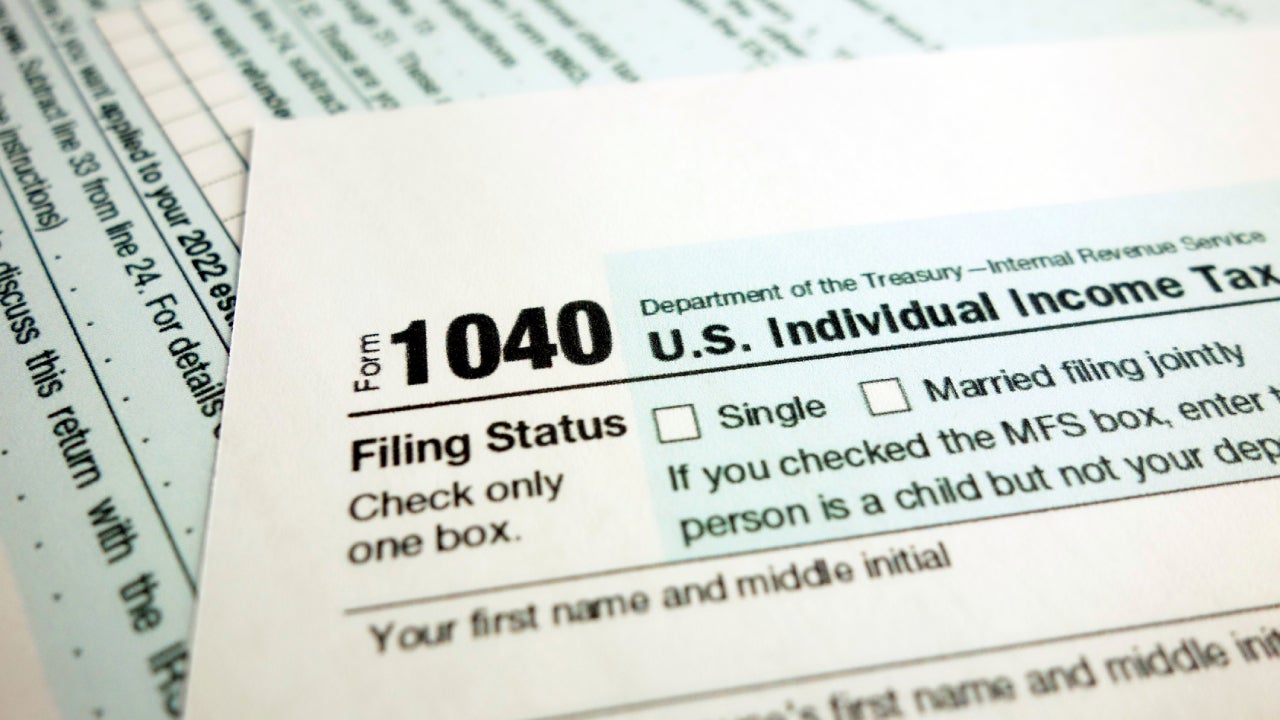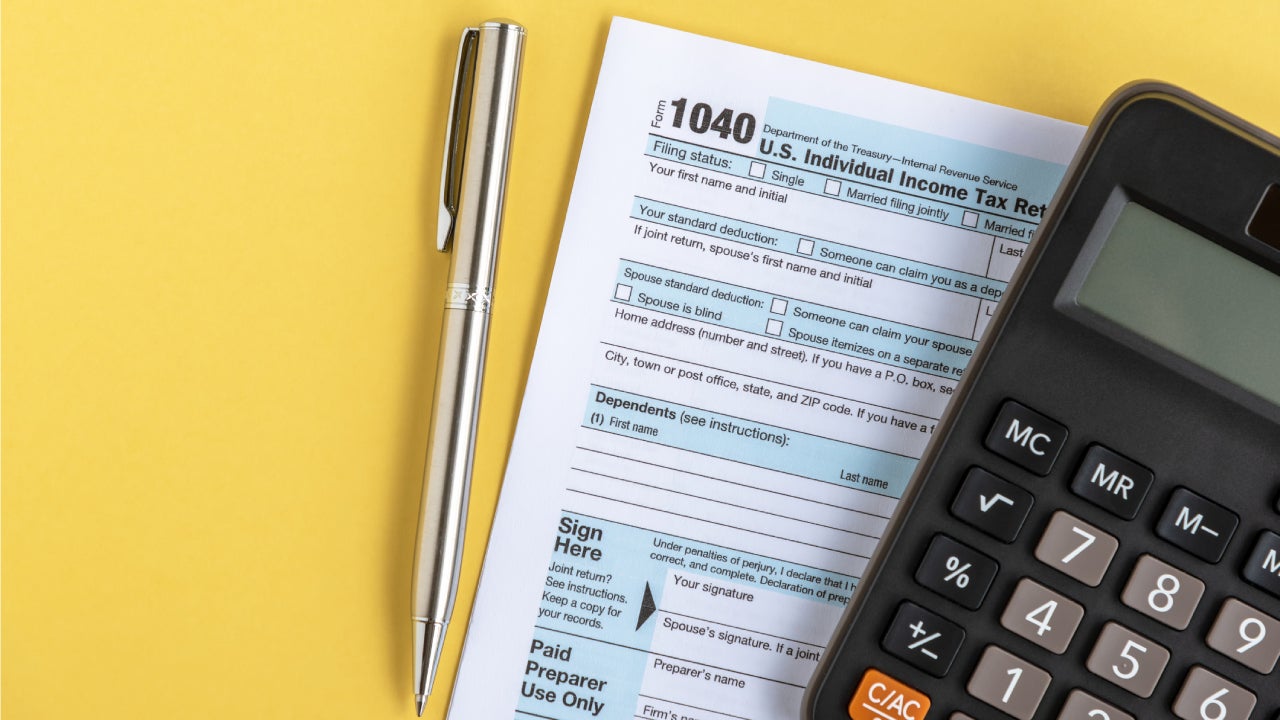2024-2025 tax brackets and federal income tax rates

Tax season is here and the deadline to file your individual tax return with the IRS is rapidly approaching. Do you know how to find your federal tax bracket?
In both 2024 and 2025, the federal income tax rates for each of the seven brackets in the U.S. are the same: 10 percent, 12 percent, 22 percent, 24 percent, 32 percent, 35 percent and 37 percent.
Your tax rate is tied to which bracket you fall into, based on your taxable income and filing status (that is, single, married filing jointly, etc.). Knowing how to find your tax bracket, and how to calculate your tax rate — both your effective tax rate and marginal tax rate — can help you make better financial decisions.
Keep in mind that the income ranges for each of those tax brackets changes annually, based on IRS inflation adjustments. The reason for the annual increase is to avoid bracket creep, where people are pushed into higher tax brackets simply because of cost-of-living pay increases.
For example, for income received in 2024, single filers will pay a 10 percent tax rate on income up to $11,600. In 2025, the top range of the 10 percent bracket for single filers increases to $11,925. If your income exceeds that tax bracket, then you still pay 10 percent on income up to $11,600 (on 2024 income for a single filer), and then 12 percent on your income from $11,600 to the top income range of the 12 percent tax bracket.
Read on for the 2024 and 2025 tax brackets and federal income tax rates, plus learn how to calculate your marginal and effective tax rates.
2024 tax brackets
The 2024 federal tax brackets and income tax rates apply to your income from the 2024 year, which you’ll report on the tax return that’s due in April 2025, or October 2025 with an extension. (It’s crucial to keep an eye on tax deadlines, especially if you owe money to the IRS.)
For 2024 taxes due in 2025, the seven income tax rates are: 10 percent, 12 percent, 22 percent, 24 percent, 32 percent, 35 percent and 37 percent.
Here are the 2024 income tax brackets for taxes due April 2025 (or October 2025 with an extension):
| Tax rate | Single | Head of household | Married filing jointly or qualifying widow | Married filing separately |
|---|---|---|---|---|
| 10% | $0 to $11,600 | $0 to $16,550 | $0 to $23,200 | $0 to $11,600 |
| 12% | $11,601 to $47,150 | $16,551 to $63,100 | $23,201 to $94,300 | $11,601 to $47,150 |
| 22% | $47,151 to $100,525 | $63,101 to $100,500 | $94,301 to $201,050 | $47,151 to $100,525 |
| 24% | $100,526 to $191,950 | $100,501 to $191,950 | $201,051 to $383,900 | $100,526 to $191,950 |
| 32% | $191,951 to $243,725 | $191,951 to $243,700 | $383,901 to $487,450 | $191,951 to $243,725 |
| 35% | $243,726 to $609,350 | $243,701 to $609,350 | $487,451 to $731,200 | $243,726 to $365,600 |
| 37% | $609,351 or more | $609,351 or more | $731,201 or more | $365,601 or more |
| Source: IRS | ||||
2025 tax brackets
The IRS has announced new tax brackets — in other words, new income ranges for each applicable tax rate — for the 2025 tax year, for taxes you’ll file in April 2026, or October 2026 if you file an extension. Brackets are adjusted each year for inflation.
For 2025 taxes due in 2026, Americans will see the same seven income tax rates as the previous year: 10 percent, 12 percent, 22 percent, 24 percent, 32 percent, 35 percent and 37 percent.
Here are the 2025 income tax brackets, for taxes due April 2026, or October 2026 with an extension:
| Tax rate | Single | Head of household | Married filing jointly or qualifying widow | Married filing separately |
|---|---|---|---|---|
| 10% | $0 to $11,925 | $0 to $17,000 | $0 to $23,850 | $0 to $11,925 |
| 12% | $11,926 to $48,475 | $17,001 to $64,850 | $23,851 to $96,950 | $11,926 to $48,475 |
| 22% | $48,476 to $103,350 | $64,851 to $103,350 | $96,951 to $206,700 | $48,476 to $103,350 |
| 24% | $103,351 to $197,300 | $103,351 to $197,300 | $206,701 to $394,600 | $103,351 to $197,300 |
| 32% | $197,301 to $250,525 | $197,301 to $250,500 | $394,601 to $501,050 | $197,301 to $250,525 |
| 35% | $250,526 to $626,350 | $250,501 to $626,350 | $501,051 to $751,600 | $250,526 to $375,800 |
| 37% | $626,351 or more | $626,351 or more | $751,601 or more | $375,801 or more |
| Source: IRS | ||||

Trump’s back in office — here’s what to expect for your taxes in 2025
During President Trump's second term, Americans may see a series of major tax-law changes.
Read moreFederal tax brackets and rates: How they work
In the U.S., tax brackets are not as intuitive as they might seem, because we have a progressive federal tax system. That means many of us have to look at more than one bracket to know our effective tax rate, which is the percentage of our income that we pay in taxes. Your marginal tax rate is your highest tax rate — that is, the tax rate you pay on your last dollar of income.
Keep in mind that you pay taxes based on your taxable income, which is your adjusted gross income (AGI) minus the standard deduction or your itemized deductions (and the qualified business income deduction, if you’re eligible for that).
What is your effective tax rate?
Your effective tax rate is the percentage of your annual income you paid to the IRS. Knowing your effective tax rate helps you understand your true tax liability each year. It’s a little harder to figure out than your marginal tax rate, which is simply the tax bracket that applies to your last dollar of income. For example, if you look at the 2025 tax rates above, if you’re a single filer and your taxable income is $48,000, then your marginal tax rate is 12 percent.
However, your effective tax rate likely will be lower than that, because a good chunk of your income will fall into the 10 percent tax bracket. Even though your marginal rate is 12 percent, not all of your income is taxed at 12 percent. That’s why knowing your effective tax rate can give you a better sense of your actual annual tax bill. Read on to see how to calculate your effective tax rate.
Your effective tax rate gives you the clearest picture of what you’re paying out of pocket. Your marginal tax rate gets applied to your next dollar of income.
— Mark Gallegos CPA and tax partner, Porte Brown, an accounting firm in Elgin, Ill.
How to calculate your effective tax rate
If you know your tax bill, it’s easy to calculate your effective tax rate from it: Simply divide your total tax by your taxable income and multiply it by 100. (Hint: Your total tax is on line 24 of Form 1040.)
For example, if you paid $20,000 in taxes over the course of the year (including any payment you made when you filed your taxes), and your taxable income is $100,000, then your effective tax rate is 20 percent. (That’s 20,000 divided by 100,000 times 100.)
However, it’s also possible to calculate your effective tax rate using just your income and the tax rates noted in the tables above. Instead of looking at what tax bracket you fall into based on your total income, you need to steadily go through each of the tax brackets, starting with the first one.
That is, you start with the first tax bracket, applying its 10 percent rate to your income up to the top of the income range for that bracket, then move on to the next bracket, applying the 12 percent rate to that portion of income.
Figuring that out isn’t as hard as it may seem.
Example: Single filer earning $40,000
Say you’re a single person with $40,000 of taxable income in 2024. As you can see from our 2024 tax rates above, you’d be in the 12 percent tax bracket (that’s your marginal tax rate), but your income wouldn’t be taxed at a 12 percent rate across the board. Instead, you’d pay 10 percent on the first $11,600 of your income, plus 12 percent on the next chunk of your income between $11,600 and $47,150 (that’s the current income range for the 12 percent rate).
Specifically, you’d pay 12 percent on $28,400, which is the amount of your income that falls into the 12 percent bracket. To get that number, you subtract $11,600 — the amount of your income subject to the 10 percent rate — from $40,000. Put another way, $11,600 of your income is subject to a 10 percent rate and $28,400 is subject to a 12 percent rate.
To get your total tax bill, you take 10 percent of $11,600, which is $1,160, and 12 percent of $28,400, which is $3,408, and add them together: $4,568. As a percentage of your taxable income, that’s an 11.42 percent effective tax rate ($4,568 divided by $40,000, and then times 100).
U.S. taxpayers’ effective tax rate is often lower than their highest tax bracket, aka their marginal rate.
Example: Single filer earning $70,000
Say you’re a single person with $70,000 of taxable income in 2024 (taxable income is what’s left after you take any deductions). You would pay 10 percent on the first $11,600 of taxable income (a $1,160 tax bill); then 12 percent on the next chunk of income from $11,600 to $47,150 (a $4,266 tax bill); then 22 percent on the remaining income (a $5,027 tax bill). Your total tax bill would be $10,453. If you divide $10,453 by your taxable income of $70,000, you get an effective tax rate of just under 15 percent, which is lower than your 22 percent top, or marginal, tax bracket.
What is your marginal tax rate?
Your marginal tax rate is the rate at which the last dollar of income is taxed. Or, to think of it another way, you can simply find the amount that matches your total taxable income in the tax bracket tables above, and the rate that applies to that amount is your marginal tax rate.
How to calculate your marginal tax rate
In the U.S., as income rises, it’s generally taxed at a higher rate. In other words, for many Americans, the last dollar earned is taxed more than the first dollar. This is what’s known as a progressive tax system. And the definition of marginal tax rate is the rate that an individual taxpayer pays on their last dollar of income.
To figure out your marginal tax rate, simply look at the tax brackets above. The tax rate that applies to the bracket that matches your income is your marginal tax rate. You can easily find the amount of your taxable income on any completed Form 1040 (on the current version of the form, taxable income is listed on line 15).
How to reduce taxable income and owe less to the IRS
Knowing your tax bracket is a great starting point for creating helpful strategies to reduce your taxes. For some taxpayers, knowing where they fall within a bracket can help them make smart decisions about, for example, how much money they can convert from a traditional IRA to a Roth IRA before they push themselves into a higher income tax bracket.
And knowing your current tax bracket may prompt you to pay closer attention to ways of reducing your taxable income, possibly even to the point where you drop into a lower tax bracket. There are two main ways to reduce your taxable income: tax credits and tax deductions (though there are other strategies as well, such as pushing income into the following year, if possible).
Here’s more on what taxable income is and how to reduce it.
Need expert guidance when it comes to managing your investments?
Bankrate’s AdvisorMatch can connect you to a CFP® professional to help you achieve your financial goals.
Tax credits
Tax credits are a dollar-for-dollar reduction in your tax bill. If you owe $3,000 in taxes but you’re eligible for $500 in tax credits, your bill drops to $2,500. For many taxpayers, tax credits offer bigger savings than deductions.
The federal government currently gives tax credits for a wide variety of taxpayer expenses, including the cost of buying solar panels for your house and the cost of adopting a child.
Americans can also use education tax credits and tax credits for the cost of child care and dependent care and for having a child, to name a few. Many states also offer tax credits.
Tax deductions
Tax credits reduce your tax bill dollar-for-dollar, while tax deductions lower the amount of your income that’s subject to taxes. There are two main types of tax deductions: above-the-line and below-the-line deductions. Below-the-line deductions are also called itemized deductions. (The “line” refers to your adjusted gross income, or AGI.)
Above-the-line deductions are subtracted from your income before calculating your AGI. If you qualify for any of the above-the-line deductions, you can claim them and claim the standard deduction. (Or you can choose to claim above-the-line deductions plus below-the-line deductions.) Some examples of above-the-line deductions are those for student loan interest, educator expenses, traditional IRA contributions and health savings account contributions.
Below-the-line deductions, also known as itemized deductions, are subtracted from your AGI to arrive at your taxable income. You must choose between claiming the standard deduction and claiming itemized deductions. Some examples of itemized deductions are: medical expenses, charitable contributions and state and local taxes.
If you have enough qualified below-the-line itemized deductions to exceed the standard deduction for your filing status (for tax year 2024, the standard deduction is $14,600 for single filers and $29,200 for married filing jointly filers), you can itemize those expenses to lower your taxable income.
To calculate how much a tax deduction will reduce your tax bill, simply multiply your marginal, or top, tax bracket by the amount of the deduction. For example, say you’re a single filer in the 22 percent tax bracket. If you claim a deduction of $1,000, that will reduce your tax bill by $220.
Doing this calculation shows how a deduction can be more valuable to taxpayers in higher tax brackets. For example, a $3,000 deductible IRA contribution will shave $1,050 off the tax bill of someone in the 35 percent tax bracket, while the same $3,000 deductible IRA contribution takes $360 off the tax bill of someone in the 12 percent tax bracket. Meanwhile, tax credits generally are more valuable than tax deductions for people in lower tax brackets.
2021-2023 tax brackets and rates
If you’re behind on filing your taxes from previous years (or simply want to assess your finances over time), you might want to revisit the federal income tax brackets. If you have an old tax debt that you owe to the IRS, the sooner you can file and start to make payments, the less money you’ll owe overall in interest and penalties.
If you don’t owe money to the IRS, getting prior year tax returns filed as soon as possible could mean a tax refund for you. Here’s just one example of how filing an old tax return could mean more money in your pocket: In December 2024 the IRS announced it would be sending out $1,400 payments to about 1 million taxpayers who were eligible for a 2021 stimulus tax credit that they never claimed.
Learn more:
You may also like

Will loan interest rate caps harm financial well-being?

Options in an IRA: Are they ever safe?







